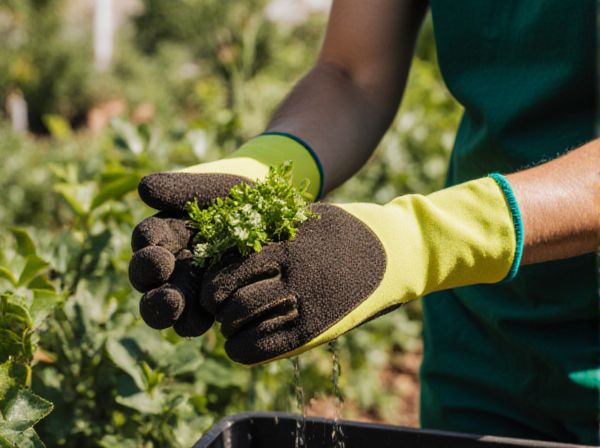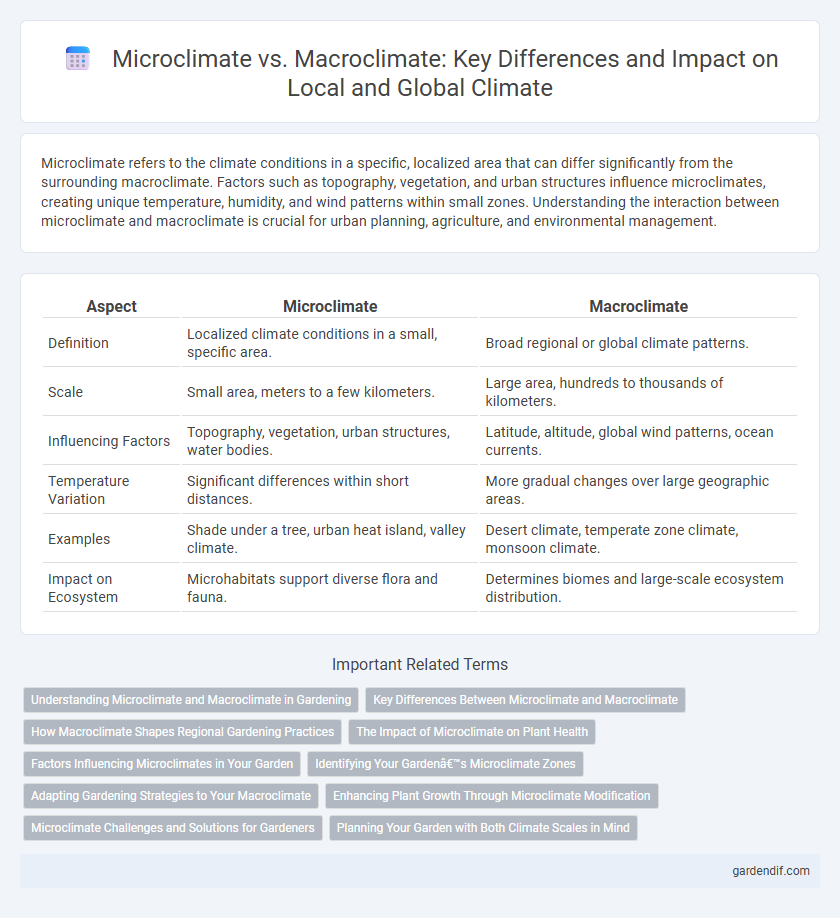
Microclimate vs Macroclimate Illustration
Microclimate refers to the climate conditions in a specific, localized area that can differ significantly from the surrounding macroclimate. Factors such as topography, vegetation, and urban structures influence microclimates, creating unique temperature, humidity, and wind patterns within small zones. Understanding the interaction between microclimate and macroclimate is crucial for urban planning, agriculture, and environmental management.
Table of Comparison
| Aspect | Microclimate | Macroclimate |
|---|---|---|
| Definition | Localized climate conditions in a small, specific area. | Broad regional or global climate patterns. |
| Scale | Small area, meters to a few kilometers. | Large area, hundreds to thousands of kilometers. |
| Influencing Factors | Topography, vegetation, urban structures, water bodies. | Latitude, altitude, global wind patterns, ocean currents. |
| Temperature Variation | Significant differences within short distances. | More gradual changes over large geographic areas. |
| Examples | Shade under a tree, urban heat island, valley climate. | Desert climate, temperate zone climate, monsoon climate. |
| Impact on Ecosystem | Microhabitats support diverse flora and fauna. | Determines biomes and large-scale ecosystem distribution. |
Understanding Microclimate and Macroclimate in Gardening
Understanding microclimate in gardening involves analyzing localized atmospheric conditions such as temperature, humidity, wind, and sunlight exposure within a specific garden area. Macroclimate refers to the broader regional climate patterns that influence seasonal weather trends, including average temperatures, precipitation levels, and prevailing wind directions. Effective gardening practices require integrating both microclimate factors, which affect plant growth on a small scale, and macroclimate conditions that determine overall suitability and resilience of plant species in a given region.
Key Differences Between Microclimate and Macroclimate
Microclimate refers to the climate of a small, specific area that can differ significantly from the surrounding macroclimate, which encompasses larger regional or global climate patterns. Key differences include scale, with microclimates affecting areas as small as a garden or urban neighborhood, while macroclimates impact entire regions or continents. Microclimates often result from local factors such as topography, vegetation, and human activities, whereas macroclimates are driven by broader atmospheric and oceanic processes.
How Macroclimate Shapes Regional Gardening Practices
Macroclimate, defined by broad atmospheric patterns and large-scale geographic factors, determines the overall temperature, precipitation, and seasonal variations that influence regional gardening practices. Gardeners adapt plant selection, planting schedules, and soil management based on macroclimatic zones such as temperate, tropical, or arid regions to optimize growth and productivity. Understanding macroclimate enables the anticipation of weather extremes and long-term climate trends essential for sustainable and resilient garden planning.
The Impact of Microclimate on Plant Health
Microclimate significantly influences plant health by modifying temperature, humidity, and sunlight exposure within localized areas, which can enhance or stress plant growth. Variations in soil moisture and wind patterns caused by microclimatic conditions directly affect nutrient uptake and disease resistance in plants. Understanding microclimate enables targeted horticultural practices that optimize plant resilience and improve crop yields in distinct environmental niches.
Factors Influencing Microclimates in Your Garden
Microclimates in your garden are shaped by factors such as sunlight exposure, topography, and proximity to water sources, which create localized variations in temperature and humidity. Vegetation density and soil composition further influence air circulation and moisture retention, directly impacting plant growth and pest activity. Understanding these elements helps gardeners optimize plant placement and improve microclimate conditions for healthier garden ecosystems.
Identifying Your Garden’s Microclimate Zones
Understanding your garden's microclimate zones involves analyzing specific factors such as sunlight exposure, soil type, and wind patterns that differ from the broader macroclimate of your region. Microclimates create unique conditions affecting plant growth, moisture levels, and temperature variations within small areas, making them crucial for selecting appropriate vegetation. Mapping these zones helps gardeners optimize plant placement, improve garden health, and enhance overall productivity.
Adapting Gardening Strategies to Your Macroclimate
Adapting gardening strategies to your macroclimate involves understanding regional temperature patterns, precipitation levels, and seasonal variations that influence plant growth on a broad scale. Selecting plant species suited to the macroclimate's hardiness zones and adjusting watering schedules based on typical rainfall improves garden resilience. Implementing soil amendments and mulching can mitigate macroclimate extremes, enhancing moisture retention and temperature regulation for optimal plant health.
Enhancing Plant Growth Through Microclimate Modification
Microclimate modification significantly enhances plant growth by creating favorable localized conditions such as optimized temperature, humidity, and wind protection. Techniques like using windbreaks, shade nets, and reflective mulches help regulate microclimates to increase crop yield and stress tolerance. Understanding the distinction between microclimate and macroclimate allows for targeted interventions that improve plant productivity in diverse environmental settings.
Microclimate Challenges and Solutions for Gardeners
Microclimate challenges for gardeners include temperature fluctuations, inconsistent sunlight exposure, and varying humidity levels that affect plant growth and health. Solutions involve creating windbreaks, using shade cloths, and employing mulch or reflective materials to moderate soil temperature and moisture. Understanding and manipulating microclimate factors can optimize garden productivity and resilience against local climatic variations.
Planning Your Garden with Both Climate Scales in Mind
Planning your garden requires understanding both microclimate and macroclimate factors. Microclimate variables like sunlight exposure, wind patterns, and soil moisture affect plant growth on a small scale, while macroclimate elements such as regional temperature, precipitation, and seasonal trends influence overall garden health. Integrating data from local weather patterns and site-specific conditions optimizes plant selection and garden design for sustainable growth.
Microclimate vs Macroclimate Infographic

 gardendif.com
gardendif.com